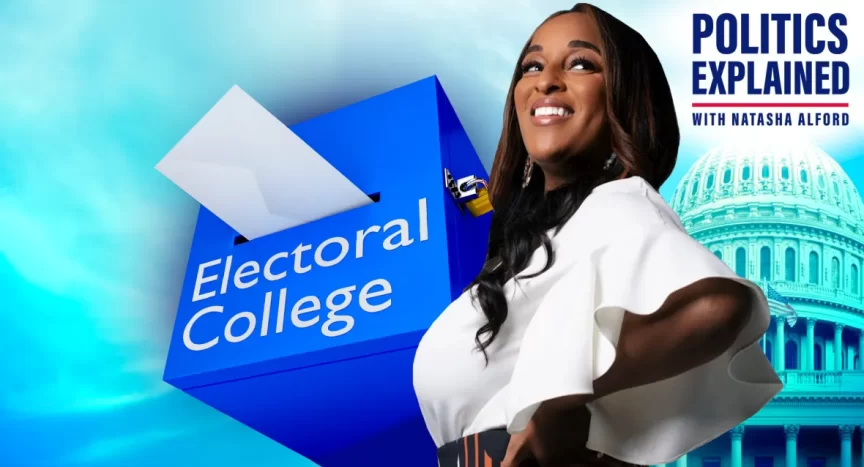You might think that in America, whoever wins the majority of votes in an election wins. But when it comes to presidential elections, that isn’t true. TheGrio’s Natasha S. Alford explains the Electoral College on this episode of “Politics Explained.”
You might think that in America, whoever wins the majority of votes in an election wins. But when it comes to presidential elections, that isn’t true.
Look no further than Al Gore and Hillary Clinton to see how America’s way of picking presidents can leave the majority of voters disappointed.
In this week’s episode of theGrio’s “Politics Explained” with Natasha Alford, we’re looking at the Electoral College and why its structure doesn’t mean “winners” actually win.
Under the Electoral College, every state gets a certain number of delegates to vote on behalf of voters in an election.
A state’s electoral votes are determined by the number of senators (2) plus the number of House representatives, which is based on the population of the state. For example, California will have 54 electoral votes (52 House of Representatives plus two senators), but a smaller state like Maine will have just 4 electoral votes.
When you add up all the states’ delegates, there are 538 electoral votes available in total. Whichever presidential candidate gets the majority of electoral votes — 270 — wins the election.
In most states, when a presidential candidate gets the majority of votes, they win all that state’s electoral votes.
For example, if Kamala Harris gets 5 million votes in one state, and Donald Trump gets only 5.1 million votes, Donald Trump will get all of the state’s electoral votes.
Under the Electoral College, each state is like its own mini-election.
Here’s where things get a little tricky. Many people think the Electoral College system isn’t fair for larger, more densely populated states, like California or New York, because in these states, one delegate has to represent so many people. The Electoral College gives smaller states with fewer people just as much power as the larger states.
Think of the Electoral College as one big family cookout. One side of the family might say they want mac and cheese as the main dish. They’re a big group with lots of members, just like the states of California and New York.
But there’s another side of the family, a little smaller in size, like the states of Arizona, Wisconsin, or Nevada. Because they have more elders, their opinions carry more weight. That means if enough of those elders want potato salad, it doesn’t matter that most of the family wants mac and cheese. The elders have an advantage in swaying what’s served.
That’s sort of how the Electoral College works. States like New York and California may have more people and are more densely populated, but their votes don’t carry as much weight as swing states, which may have fewer people but more heavily weighted electoral votes.
This is why candidates end up spending so much time in places where Electoral College votes are weighted more heavily and where the outcome isn’t predictable. It’s assumed a place like New York will vote Democratic and Texas will vote Republican, but in Wisconsin, it’s not a guarantee.
This is also why voters must pay attention to rule changes happening across the country right before our eyes — like in Georgia, where a pro-Trump group in power recently voted that all ballots must be hand-counted, millions of ballots, before the state’s deadline to certify the vote. It’s a rule change that will likely slow down the election results.
If you’re wondering why the United States adopted the Electoral College despite criticisms throughout the years, the history of slavery did play a part. While constructing the Constitution, Northern and Southern states agreed upon the Three-Fifths Compromise, which meant an enslaved person would count as three-fifths of a person. This compromise ensured the South wouldn’t be outnumbered by the more heavily populated North. Essentially, slave bodies could count towards representation, even though enslaved people couldn’t vote.
Keeping the Electoral College system protected Southern interests.
So, if you’re voting this year, remember everything that was done to preserve the status quo back then, and take nothing for granted about how far people will go to tip the scales in their favor now.
For more political explainers and the latest in Election 2024 coverage, follow TheGrio’s Politics section.
Recommended Stories
- ‘Politics Explained’: Is Biden or Trump to blame for inflation? And how will Harris or Trump change the economy?
- Why do Black voters usually vote with the Democratic party? A deep dive into history explains.
- Politics Explained: How to protect your vote in 2024
- ‘Power Book II: Ghost’ Season 4, Episode 8: Everybody is making so, so many bad decisions that they should all end up dead
- Nicki Minaj and Eve prove that they are both ‘that girl’ in refreshing interaction
!function(){var g=window;g.googletag=g.googletag||{},g.googletag.cmd=g.googletag.cmd||[],g.googletag.cmd.push(function(){g.googletag.pubads().setTargeting(“has-featured-video”,”true”)})}(); ( () => { ( ( cb ) => { window.tpd = window.tpd || {}; if ( true === tpd.cmpReady ) { console.log( ‘[TPD][Brid] CMP was already ready, running player.’ ); cb(); return; } let tpdCmpReadyListener = () => { console.log( ‘[TPD][Brid] CMP ready event fired, running player.’ ); window.removeEventListener( ‘tpd:cmpCb’, tpdCmpReadyListener ); cb(); }; window.addEventListener( ‘tpd:cmpCb’, tpdCmpReadyListener ); } )( () => { let s = document.createElement( ‘script’ ); s.src = ‘https://player.target-video.com/player/build/targetvideo.min.js’; s.async = true; let target = document.getElementById( ‘Brid_1769200’ ); target.parentElement.insertBefore( s, target ); window._bp = window._bp || []; window._bp.push( {“div”:”Brid_1769200″,”obj”:{“id”:”41122″,”width”:”1280″,”height”:”720″,”stickyDirection”:”below”,”video”:”1769200″,”slide_inposition”:”.widget_tpd_ad_widget_sticky”}} ); } ); } )();






